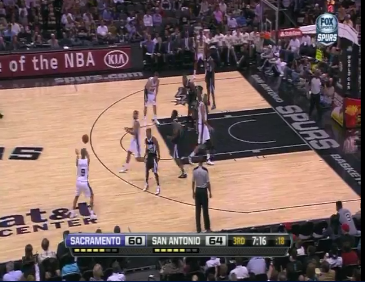(Image from http://www.48minutesofhell.com)
The San Antonio Spurs serve as a direct contradiction to the “old dog new tricks cliché.” After winning four championships with a Tim Duncan in the post-centric, slow paced offense, the Spurs began the shift towards their modern offense, relying on off ball movement, misdirection, and Tony Parker’s creation out of the pick and roll to generate offense. They had seemingly perfected the system by the 2011-2012 season, when they finished first overall in offensive rating at 112.4 points per 100 possessions. The Spurs had struggled defensively in recent years, but finished this season ranked third in defensive efficiency, surrendering only 101.6 points per 100 possessions. Prior to the 2011 season, they traded effective guard George Hill to Indiana for the first round pick that became Kawhi Leonard.
The Spurs have never been hesitant to make changes, but in last year’s conference finals, were unable to adapt to the Kevin Durant pin-downs the Thunder ran repeatedly.
Here is the basic alignment of a double pin-down set. 5 and 4 are setting pin down screens for 1 and 2. The pin down allows a player to receive the ball in good scoring position, allows for an easy entry pass, and provides an easy set up for a pick and roll close to the basket.
Here is an example of the pin-down play the Thunder used to beat San Antonio:
The Spurs, famous for their own innovation, have adopted the pin-down screen as an important feature of their offense. They often set up pick and rolls or open jump shots by setting pin down screens for Tony Parker, but recently, have been running an inverted pin down, in which a guard is setting a screen for the big man (almost always Duncan).
To begin this play Tony Parker dribbles the ball up the court, towards the left baseline. Tiago Splitter waits in the high right post, and Duncan runs to the left low block. Gary Neal cuts from the left corner to the top, and Parker passes him the ball, filling Neal’s position in the left corner.
Tiago Splitter moves towards the three point line and receives a pass from Neal. Duncan is now the only offensive player in the middle of the court, and is flanked by two Spurs ready for a corner three point attempt. Kawhi Leonard shoots 38.9 percent from the left corner three, and though this may appear low it is the equivalent of a 58.3 percent field goal percentage on a two point field goal attempt, while Parker shot 47.6 percent on his 19 right corner three attempts.
Neal sets the pin down screen for Duncan, freeing him for the in-rhythm midrange jump shot. This season, Duncan shot 43.4 percent on 272 midrange jump shots, many of which came off pick and pops or plays similar to this. Neal is still holding the screen, and had the shot been better contested, Duncan is in excellent position to drive, in which case Isaiah Thomas would likely have helped off of Tony Parker, freeing Parker for an open corner three.
As has come to be expected of San Antonio, the intricate Spurs have added several variations of this pin down set to their offense.
On this play, Duncan is positioned at the short corner on the right side of the court when he receives the pin down. Instead of coming vertically off the screen, he curls towards the right elbow, where he takes the open jumper off a pass from Manu Ginobli.
The Clippers’ defense of the Duncan pin down partly reveals why it is effective. Had a guard been coming off the screen, the DeAndre Jordan would likely have hedged, following the guard towards the elbow and denying a driving lane while the Clippers’ screened guard recovered. Normally, this would allow the Spurs guard to pass back to the screen setter for an open short-corner jump shot. The Clippers do not take this approach with Duncan, and appear confused with how to defend the play. Possibly because Leonard is perceived as a greater threat to take the jumper, his defender is unwilling to hedge on Duncan while Jordan struggles around the screen. Also, because guards are not accustomed to guarding screen setters, this likely is a miscommunication by the defense. Duncan takes the wide open jump shot, foreshadowing the Spurs’ final play of the game.
In this game-winning play, the Spurs again run a pin down screen for Duncan, who enters the cut earlier than expected. Jordan scrambles to beat the screen and catch Duncan, who hesitates after catching and draws the foul on Jordan as he hits the game wining shot.
The pin down adds yet another fold in the Spurs often-dynamic offense, and represents the Spurs continual willingness to reshape and adapt their roster, style, and strategy.







